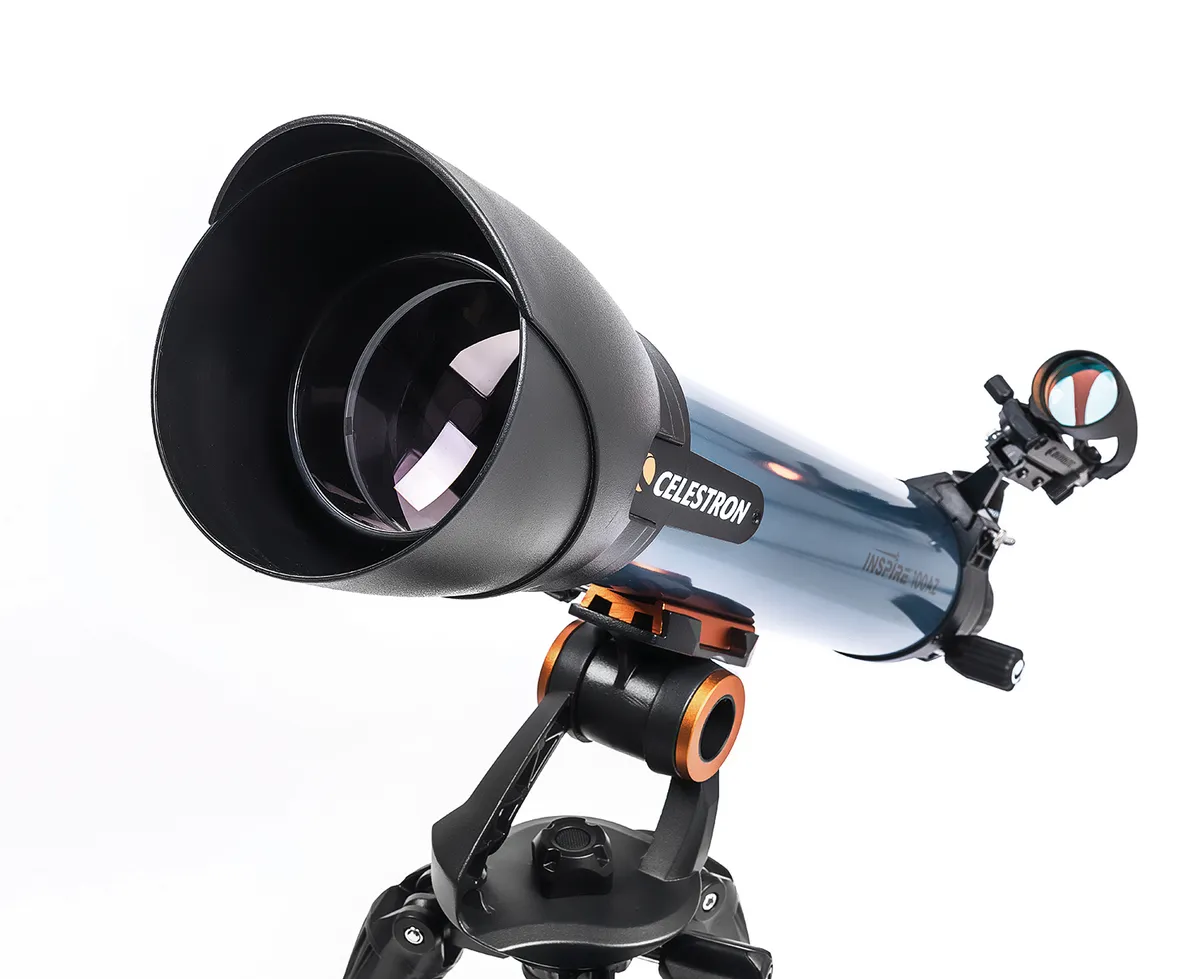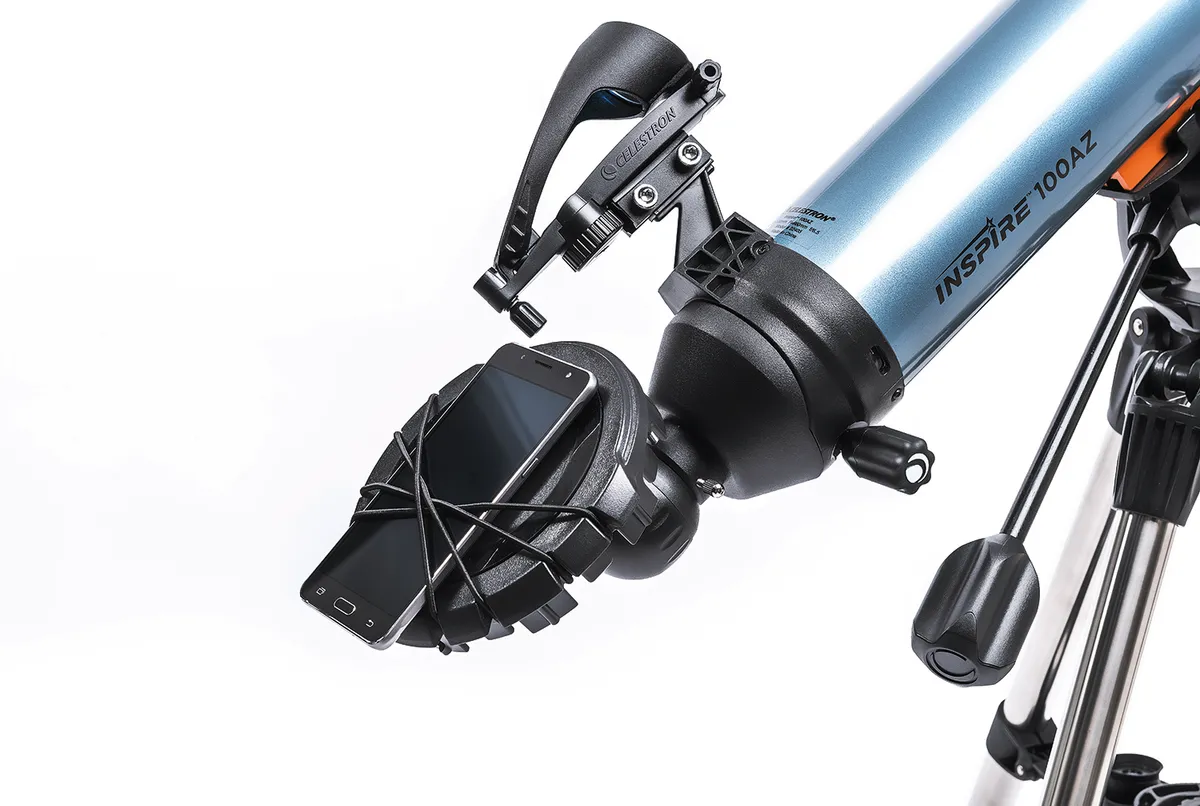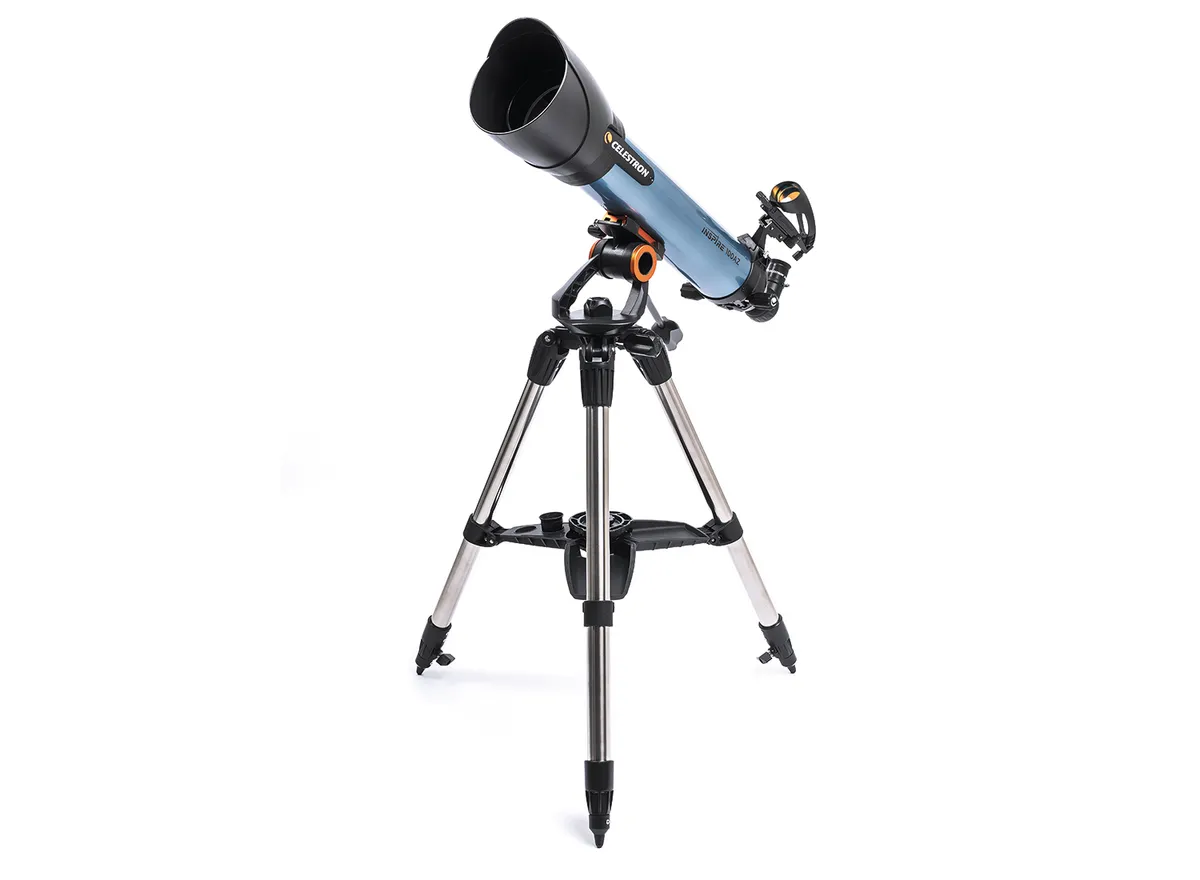The Celestron Inspire 100AZ offers a complete observing package with a good-sized aperture, a focal length of 660mm and plenty of features at a reasonable cost.
This telescope would appeal to beginners and younger astronomers in particular, as it’s not only affordable but also attractively designed.
SQUIRREL_13194570
This telescope features in our lists of the best telescopes for beginners, the best telescopes for astrophotography, best telescopes for kids and the best budget telescopes

The 100mm-wide alloy optical tube is finished in a light metallic blue gloss paint with black plastic fittings and an orange, Vixen-style dovetail bar.
The tripod has a robust and modern-looking asymmetrical pan and tilt head with 32mm-diameter, stainless-steel adjustable-height legs.
As well as the 20mm and 10mm Kellner eyepieces supplied, there’s a 90° erect image diagonal included, meaning the telescope is also suitable for terrestrial observations.
Completing the package is a useful red light LED torch, accessory tray/leg spreader and a dual-purpose dust cap.
At just 6.1kg the whole assembly is light and easy to carry around even when it’s fully assembled, making it ideal for impromptu observing sessions.
The ease with which it can be set up is a real bonus for allowing beginners to get on with observing as quickly as possible.

Celestron Inspire 100AZ Focus and colour
The Celestron Inspire 100AZ's achromatic doublet lens is fully coated. It’s only a thin coating, but it’s evenly applied with no bad spots.
Stars examined through the Inspire 100AZ retained good shapes up to almost 80% of the field of view.
As expected, bright stars showed some chromatic aberration but, generally, the correct star colours were observed.
Orange Aldebaran, the blue-white Pleiades and the lovely contrasting pair of Albireo were all accurately represented.
The Celestron Inspire 100AZ gave us early evening views of Venus, where the planet’s phase was easily observed and Mars was very clearly a non-stellar red disc.
Lunar observations were particularly enjoyable, with plenty of detail visible in the craters and not too much false colour on the limb.
That said, however, the 20mm eyepiece afforded much better views than the 10mm eyepiece, which was rather lacklustre.
The Double Cluster in Perseus showed well through the 20mm eyepiece and the view through the telescope took less than five seconds to stabilise after it had been given a sharp knock.
Use your smartphone
The dust cap has a smartphone holder built into it and we used this to capture a video of the Moon through the 20mm eyepiece.
Stacking the results into a single image produced a pleasant picture for such a basic set of components, despite the rather poor seeing conditions.
Beginners would have a lot of fun with this feature, although a phone isn’t sensitive enough for deep-sky objects.
Although we were able to achieve focus perfectly adequately, the single-speed rack and pinion focuser is the Inspire 100AZ’s weak point.
Made with several plastic parts that made it floppy when racking in and out it doesn’t inspire confidence in the product, although this is a minor niggle.
The tripod and mount are nicely produced and the solid, 30cm-long tilt handle made locating objects simple.
A quick twist to lock the altitude in place, leaving the azimuth with just a small amount of friction, allowed us to track objects as they moved across the sky.
After an initial alignment with the main telescope, the red dot finder proved useful and, again, is an ideal addition for beginners taking their first steps into stargazing – especially if they’re learning how to find objects by star hopping with a star chart and the supplied red flashlight.
The Inspire 100AZ telescope would be most suitable for younger beginners as the views and versatility would keep their interest going.
Dust cap camera mount
Although this telescope and its non-motorised mount are not designed with astrophotography in mind, the Inspire 100AZ’s dust cap has a novel feature.
You can strap a smartphone to it and then attach the pairing to one of the two eyepieces that come with the scope.
Although your smartphone camera already has a lens and therefore can’t be used at prime focus, light collected by the telescope can be projected into your phone’s camera by an eyepiece in a process known as afocal photography.
For this process to work, it’s important that your camera’s lens is aligned centrally with the eyepiece and the adjustable elastic straps on the dust cap make doing that easy.
Next, the dust cap is placed over the eyepiece and held in position with two thumbscrews.
It’s then a simple matter of pointing the Inspire 100AZ at a Solar System object (including the Sun if a suitable front-mounted solar filter is used), adjusting the focus and capturing a short video for processing in AutoStakkert! or RegiStax.

Celestron Inspire 100AZ best features
StarPointer Pro red dot finder
The stylish StarPointer Pro red dot finder projects a reticule onto the view, making it easy to align with Solar System objects or bright stars.The light intensity is adjustable and alignment with the main telescope is easy using two thumbscrews to adjust its mounting platform.
Doublet lens
The Inspire 100AZ has an achromatic doublet objective lens with a generous aperture of 4 inches, the largest in the Inspire range. Larger apertures increase the light grasp of a telescope making it easier to observe dimmer objects. The fully coated lens surfaces increase light transmission by decreasing reflections.
10mm & 20mm eyepieces
The 10mm and 20mm 1.25-inch Kellner eyepieces supplied are suitable for a wide range of observations, providing magnifications of 66x and 33x respectively. They have basic fold-down rubber eyecups, but there isn’t quite enough eye relief for observing the whole field of view with spectacles.
Easy-to-assemble tripod
The steel-tube tripod has extendable legs with simple locking handles. There’s a built-in folding accessory tray that doubles as a leg spreader to help stabilise the tripod. The spreader is locked in place by folding it out and twisting a locking capstan.
Rack and pinion focuser with micrometer scale
A simple single-speed rack and pinion focuser with 1.25-inch eyepiece holder is supplied. It has two eyepiece-retaining thumbscrews to hold the star diagonal securely. On the right-hand side of the focuser there’s a convenient window showing an etched scale so that you can quickly locate previous focus positions.
Celestron Inspire 100AZ key specs
- Optics: Achromatic lens
- Aperture: 100mm (4 inches)
- Focal Length: 660mm, (f/6.5)
- Focuser: Single-speed rack and pinion with micrometer scale
- Mount: Manual Altazimuth
- Extras: Red-dot finder, erect image star diagonal, 10mm and 20mm eyepieces, red light LED torch, printed instruction manual
- Weight: 6.1kg
- Supplier: David Hinds
- www.celestron.uk.com
- Tel 01525 852696
Steve Richards is an experienced astronomer. This review first appeared in the April 2017 issue of BBC Sky at Night Magazine.
